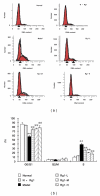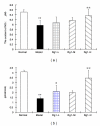Inhibitory Effect of Ginsenoside Rg1 on Vascular Smooth Muscle Cell Proliferation Induced by PDGF-BB Is Involved in Nitric Oxide Formation
- PMID: 22474498
- PMCID: PMC3304546
- DOI: 10.1155/2012/314395
Inhibitory Effect of Ginsenoside Rg1 on Vascular Smooth Muscle Cell Proliferation Induced by PDGF-BB Is Involved in Nitric Oxide Formation
Abstract
Ginsenoside Rg1 (Rg1) has been reported to suppress the proliferation of vascular smooth muscle cells (VSMCs). This study aimed to observe the role of nitric oxide (NO) in Rg1-antiproliferative effect. VSMCs from the thoracic aorta of SD rats were cultured by tissue explant method, and the effect of Rg1 (20 mg·L(-1), 60 mg·L(-1), and 180 mg·L(-1)) on platelet-derived growth factor-BB (PDGF-BB)-induced proliferation was evaluated by MTT assay. The cell cycle was analyzed by flow cytometry. For probing the mechanisms, the content of NO in supernatant and cGMP level in VSMCs was measured by nitric oxide kit and cGMP radio-immunity kit, respectively; the expressions of protooncogene c-fos and endothelial NO synthase (eNOS) mRNA in the VSMCs were detected by real-time RT-PCR; the intracellular free calcium concentration ([Ca2(+)](i)) was detected with Fura-2/AM-loaded VSMCs. Comparing with that in normal group, Rg1 180 mg·L(-1) did not change the absorbance of MTT and cell percent of G(0)/G(1), G(2)/M, and S phase in normal cells (P > 0.05). Contrarily, PDGF-BB could increase the absorbance of MTT (P < 0.01) and the percent of the S phase cells but decrease the G(0)/G(1) phase cell percent in the cell cycle, accompanied with an upregulating c-fos mRNA expression (P < 0.01), which was reversed by additions of Rg1(20 mg·L(-1), 60 mg·L(-1), and 180 mg·L(-1)). Rg1 administration could also significantly increase the NO content in supernatant and the cGMP level in VSMCs, as well as the eNOS mRNA expression in the cells, in comparison of that in the group treated with PDGF-BB alone (P < 0.01). Furthermore, Rg1 caused a further increase in the elevated [Ca(2+)](i) induced by PDGF-BB. It was concluded that Rg1 could inhibit the VSMC proliferation induced by PDGF-BB through restricting the G(0)/G(1) phase to S-phase progression in cell cycle. The mechanisms may be related to the upregulation of eNOS mRNA and the increase of the formation of NO and cGMP.
Figures





References
-
- Hin H, Liu Z, Li F, et al. Ginsenoside Rg1 enhances angiogenesis and amelioeates ventricular remodeling in a rat model of myocardial infarction. Journal of Molecular Medicine. 2011;89(4):363–375. - PubMed
-
- Deng J, Lv XT, Wu Q, Huang XN. Ginsenoside Rg1 inhibits rat left ventricular hypertrophy induced by abdominal aorta coarctation: involvement of calcineurin and mitogen-activated protein kinase signalings. European Journal of Pharmacology. 2009;608(1–3):42–47. - PubMed
-
- Zhu D, Wu L, Li CR, et al. Ginsenoside Rg1 protects rat cardiomyocyte from hypoxia/reoxygenation oxidative injury via antioxidant and intracellular calcium homeostasis. Journal of Cellular Biochemistry. 2009;108(1):117–124. - PubMed
-
- Ma ZC, Gao Y, Wang YG, Tan HL, Xiao CR, Wang SQ. Ginsenoside Rg1 inhibits proliferation of vascular smooth muscle cells stimulated by tumor necrosis factor-α . Acta Pharmacologica Sinica. 2006;27(8):1000–1006. - PubMed
-
- Zhang HS, Wang SQ. Ginsenoside Rg1 inhibits tumor necrosis factor-α (TNF-α)- induced human arterial smooth muscle cells (HASMCs) proliferation. Journal of Cellular Biochemistry. 2006;98(6):1471–1481. - PubMed
LinkOut - more resources
Full Text Sources
Miscellaneous

